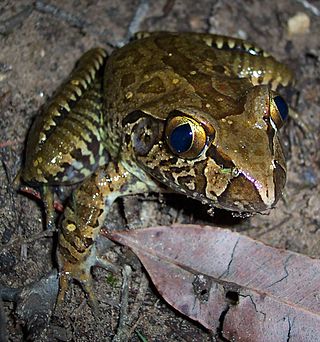
Conondale National Park is 130 km north of Brisbane in the Sunshine Coast Hinterland near the town of Conondale in the south east Queensland bioregion. The park covers an area of 35,648 hectares protecting large areas of subtropical rainforest, woodlands, wet and dry sclerophyll forest including Queensland's tallest tree. The park contains areas of regenerating forest which have been previously logged; areas of forest plantations also border the park. The park is currently managed by the Queensland Government under the Nature Conservation Act 1992.
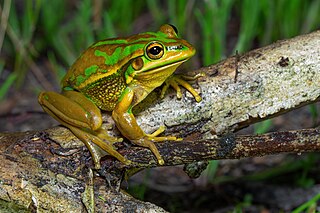
The green and golden bell frog, also named the green bell frog, green and golden swamp frog and green frog, is a species of ground-dwelling tree frog native to eastern Australia. Despite its classification and climbing abilities, it does not live in trees and spends almost all of its time close to ground level. It can reach up to 11 cm (4.5 in) in length, making it one of Australia's largest frogs.

The Baw Baw frog is a critically endangered species of Australian frog as categorised on the IUCN Red List and listed under the Flora and Fauna Guarantee Act (1988). It has suffered a decline in population, mostly due to infection caused by chytrid fungus. Zoos Victoria has undertaken a breeding program to ensure survival of the species which commenced in 2010, and in October 2018 successfully collected the first eggs laid in captivity.

The magnificent tree frog, also known as the splendid tree frog, is a species of tree frog first described in 1977. It has a limited range, only occurring on the north-western coast of Australia in the Northern Territory and Western Australia. It has a similar appearance to, and can be confused with, the closely related White's tree frog.

The spotted grass frog or spotted marsh frog is a terrestrial frog native to Australia. It is distributed throughout all of New South Wales and Victoria, eastern South Australia, the majority of Queensland, and eastern Tasmania. It is also naturalised in Western Australia, having been unintentionally introduced at Kununurra in the 1970s, apparently during the relocation of several hundred transportable homes from Adelaide.

The southern toad is a true toad native to the southeastern United States, from eastern Louisiana and southeastern Virginia south to Florida. It often lives in areas with sandy soils. It is nocturnal and spends the day in a burrow. Its coloring is usually brown but can be red, gray, or black. It is approximately 8 cm (3 inches) long.

The Italian agile frog, also known as Lataste's frog, is a species of frog in the family Ranidae. The species is native to southern Europe, primarily found in the Po River Basin of Italy. It is one of the most endangered amphibian species in Europe, with its populations declining sharply in recent years, and has been the focus of multiple conservation plans.

The Pine Barrens tree frog is a species of New World tree frog. It is becoming rare due to habitat loss.
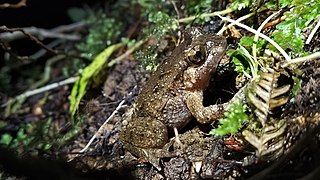
Hochstetter's frog or Hochstetter's New Zealand frog is a primitive frog native to New Zealand, one of only four extant species belonging to the taxonomic family Leiopelmatidae. They possess some of the most ancient features of any extant frogs in the world.

The pig frog is a species of aquatic frog found in the Southeastern United States, from South Carolina to Texas. Some sources also refer to it as the lagoon frog or the southern bullfrog.
Geocrinia alba, commonly known as the white-bellied frog, is a small frog in the family Myobatrachidae. It occupies an area near Margaret River in swampy depressions adjoining creeks. Threats from altered ecology have made this a critically endangered species of south-western Australia.
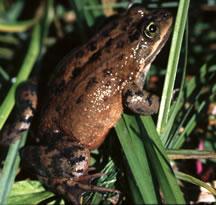
The Oregon spotted frog is a member of the frog family Ranidae of order Anura. It is a medium-sized aquatic frog endemic to the Pacific Northwest and historically well distributed in the Puget Trough/Willamette Valley province and the Cascade Mountains of south-central Washington and Oregon. It is relatively rare within its range and is listed globally as vulnerable.

Pelophylax nigromaculatus, is a species of true frog found in East Asia, first described in 1861. This widespread and common frog has many common names, including dark-spotted frog, black-spotted pond frog, and black-spotted frog.

Nymphargus grandisonae is a species of frog in the family Centrolenidae. It is found in Andes of Colombia and Ecuador. Its natural habitat is tropical moist montane forest ; larvae develop in streams and still-water pools. Its habitat is threatened by habitat loss, introduced fish, and agricultural pollution, but it is still a common species not considered threatened by the IUCN.

Geocrinia laevis, the smooth frog, southern smooth froglet, smooth froglet, or Tasmanian smooth frog, is a species of frog in the family Myobatrachidae. It is endemic to Australia and found in Tasmania, southwestern Victoria, and the extreme southeast of South Australia.
Geocrinia rosea, the karri or roseate frog is a species in the family, Myobatrachidae. It is endemic to Southwest Australia.
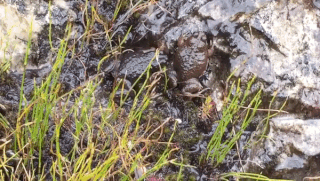
Poyntonia, is a monotypic frog genus in the family Pyxicephalidae. It was named after J.C. Poynton, a notable herpetologist who worked in southern Africa.

The Bombay night frog, also known as Abdulali's wrinkled frog, Abdulali's night frog or Humayun's wrinkled frog, is a species of frog in the family Nyctibatrachidae. It is endemic to the Western Ghats of Maharashtra state, India. The species is found near torrential hill streams in tropical moist evergreen and semi-evergreen forests, a habitat that is threatened by habitat loss and pollution. Its name honours Humayun Abdulali, an Indian biologist.
The Amphibians of Western Australia are represented by two families of frogs. Of the 78 species found, most within the southwest, 38 are unique to the state. 15 of the 30 genera of Australian frogs occur; from arid regions and coastlines to permanent wetlands.
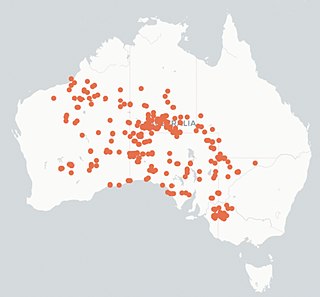
Ctenotus brooksi, also known commonly as Brooks' wedge-snouted ctenotus, the wedgesnout ctenotus, and the sandhill ctenotus, is a species of skink, a lizard in the family Scincidae. The species is endemic to Australia and found in semi-arid regions.

















